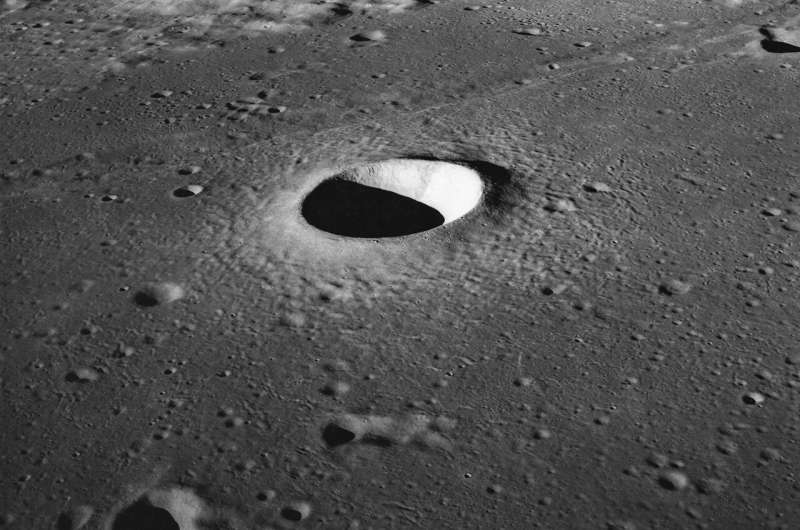
Copernical Team
NASA's Ingenuity helicopter completes 12th Mars flight
 NASA's Ingenuity helicopter completed its 12th flight on Mars, officials said early Tuesday, as it scouts out the Martian terrain for the Perseverance land rover.
The 4-pound autonomous aircraft flew over the South Seitah region of the Red Planet, traveling a total of 1,476 feet round trip at a height of nearly 33 feet for 169 seconds, NASA's Jet Propulsion Laboratory said via Twitter.
NASA's Ingenuity helicopter completed its 12th flight on Mars, officials said early Tuesday, as it scouts out the Martian terrain for the Perseverance land rover.
The 4-pound autonomous aircraft flew over the South Seitah region of the Red Planet, traveling a total of 1,476 feet round trip at a height of nearly 33 feet for 169 seconds, NASA's Jet Propulsion Laboratory said via Twitter. NASA benefits from Lunar surface simulant testing
 To safely reach the Moon, a lunar lander must fire its rocket engines to decelerate the spacecraft for a soft touchdown. During this process, the engine exhaust stirs up regolith - the dust and rocks on the lunar surface - creating a host of potential challenges, from destabilizing the lander to damaging instruments and reducing visibility.
To dig into this problem, a team from NASA's Kenn
To safely reach the Moon, a lunar lander must fire its rocket engines to decelerate the spacecraft for a soft touchdown. During this process, the engine exhaust stirs up regolith - the dust and rocks on the lunar surface - creating a host of potential challenges, from destabilizing the lander to damaging instruments and reducing visibility.
To dig into this problem, a team from NASA's Kenn Curiosity Mars Rover explores a changing landscape
 Images of knobbly rocks and rounded hills are delighting scientists as NASA's Curiosity rover climbs Mount Sharp, a 5-mile-tall (8-kilometer-tall) mountain within the 96-mile-wide (154-kilometer-wide) basin of Mars' Gale Crater. The rover's Mast Camera, or Mastcam, highlights those features in a panorama captured on July 3, 2021 (the 3,167th Martian day, or sol, of the mission).
This locat
Images of knobbly rocks and rounded hills are delighting scientists as NASA's Curiosity rover climbs Mount Sharp, a 5-mile-tall (8-kilometer-tall) mountain within the 96-mile-wide (154-kilometer-wide) basin of Mars' Gale Crater. The rover's Mast Camera, or Mastcam, highlights those features in a panorama captured on July 3, 2021 (the 3,167th Martian day, or sol, of the mission).
This locat Europe's Vega rocket blasts off with Airbus observation satellite

A European Vega rocket lifted off Monday night from French Guiana carrying an Earth observation satellite and four miniature "cubesats".
It was the second launch this year of the Vega, a crucial component of European ambitions to compete with rivals such as Elon Musk's SpaceX in the booming commercial aerospace market.
The rocket blasted off from the Guiana Space Centre in Kourou at 10:47 pm (0147 GMT), successfully delivering the satellites in just under two hours.
Its main cargo was a high-resolution satellite, the second of four for a new Earth observation constellation operated by Airbus. The first was put in orbit in April by a Vega rocket.
The Pleiades Neo constellation will offer high-resolution imaging of Earth for military or civilian uses such as disaster response, according to Airbus.
Vega's operator Arianespace is a subsidiary of the ArianeGroup, of which Airbus owns half.
Blue Origin sues NASA over SpaceX Moon contract

Blue Origin, the space company owned by Jeff Bezos, is suing the US government over its decision to award a massive Moon exploration contract to its competitor SpaceX, it said in a statement Monday.
The company has filed a suit with the US Court of Federal Claims "in an attempt to remedy the flaws" in how the contract was awarded, according to the statement.
The human landing system (HLS) contract, worth $2.9 billion, was given to SpaceX, owned by Bezos's billionaire rival Elon Musk, in April.
It was protested by the other bidders, who argued NASA was required to make multiple awards and that the evaluation process was unfair.
"We firmly believe that the issues identified in this procurement and its outcomes must be addressed to restore fairness, create competition, and ensure a safe return to the Moon for America," Blue Origin said.
Since losing the contract, Blue Origin has strongly lobbied to have the decision reversed.
Indian Space Research Organisation fails to place earth observation satellite in orbit
 On Thursday, the Indian Space Research Organisation (ISRO) was scheduled to launch Earth observation satellite EOS-03 on the GSLV launcher. The mission was initially expected to be carried out in March 2020 but was postponed due to the coronavirus pandemic.
The Earth observation satellite EOS-03, launched on Thursday from the Satish Dhawan Space Centre (SDSC) SHAR in Sriharikota, failed to
On Thursday, the Indian Space Research Organisation (ISRO) was scheduled to launch Earth observation satellite EOS-03 on the GSLV launcher. The mission was initially expected to be carried out in March 2020 but was postponed due to the coronavirus pandemic.
The Earth observation satellite EOS-03, launched on Thursday from the Satish Dhawan Space Centre (SDSC) SHAR in Sriharikota, failed to NASA at your table: where food meets methane
 Today, human sources are responsible for 60% of global methane emissions, coming primarily from the burning of fossil fuels, decomposition in landfills and the agriculture sector. Nearly a quarter of methane emissions can be attributed to agriculture, much of which is from raising livestock. Rice cultivation and food waste are also important sources of agricultural methane, as nearly a third of
Today, human sources are responsible for 60% of global methane emissions, coming primarily from the burning of fossil fuels, decomposition in landfills and the agriculture sector. Nearly a quarter of methane emissions can be attributed to agriculture, much of which is from raising livestock. Rice cultivation and food waste are also important sources of agricultural methane, as nearly a third of NASA tests machine to power the future of aviation propulsion
 A one-megawatt electric motor that could help propel future, more environmentally friendly and economically sustainable aircraft was tested during April and May by NASA and its industry and academic partners.
The center of attention is an electric machine that can work either as an electric motor to turn propellers or large engine fans, or a generator to produce one million watts of power
A one-megawatt electric motor that could help propel future, more environmentally friendly and economically sustainable aircraft was tested during April and May by NASA and its industry and academic partners.
The center of attention is an electric machine that can work either as an electric motor to turn propellers or large engine fans, or a generator to produce one million watts of power USSF establishes 2nd Field Command, Guetlein assumes command
 The U. S. Space Force established the second of its three field commands in a ceremony here Aug. 13, as Space Force Lt. Gen. Michael A. Guetlein assumed command of Space Systems Command.
Speaking during the establishment ceremony, Space Force Chief of Space Operations Gen. John W. "Jay" Raymond emphasized the important work that lies ahead for Guardians and Airmen of SSC. "America relies o
The U. S. Space Force established the second of its three field commands in a ceremony here Aug. 13, as Space Force Lt. Gen. Michael A. Guetlein assumed command of Space Systems Command.
Speaking during the establishment ceremony, Space Force Chief of Space Operations Gen. John W. "Jay" Raymond emphasized the important work that lies ahead for Guardians and Airmen of SSC. "America relies o Space EA Systems delivers satellite-enabled quantum-proof cybersecurity and innovation
 Space EA's new post-quantum encryption network defeats quantum's destructive effect against security, while enabling satellite architectures and communication networks the ability to harness quantum's power for DoD and commercial clients in the space sector.
The advent of quantum computing renders all current security obsolete, causing a perfect storm with the convergence of more and more
Space EA's new post-quantum encryption network defeats quantum's destructive effect against security, while enabling satellite architectures and communication networks the ability to harness quantum's power for DoD and commercial clients in the space sector.
The advent of quantum computing renders all current security obsolete, causing a perfect storm with the convergence of more and more 